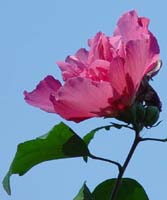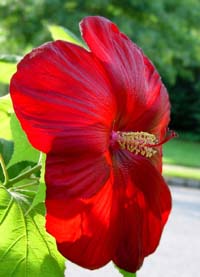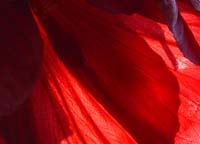|
Backlighting is the bane of the typical photograph: sending features into deep shadow, obscuring everything one hoped to capture. However, with a little luck and planning, a backlit photo displays both detail and drama.
The thumbnails that follow link into their larger version which averages between 35 and 70K.
|
|
Roses of Sharon are absolutely beautiful and a joy to photograph, and on a bright day offer many different opportunities. There are two Rose of Sharon trees (or bushes?) at Saddle Rock, one pink-red and the other white. The reddish ones are ideal for backlighting, although in this first one the backlighting is somewhat minor, with the sun off to my left.
|
|
The second Rose of Sharon was much higher up, requiring a full zoom, but the resulting color range varies from black to sheer transparency.
|
|
Sue coined the name "satellite flower" for these blooms, which are well over a foot (25 cm) in diameter. Although photographing these perennials for a few years, I've noticed for the first time that the stamen are exactly the same as that of a hibiscus, so I presume that they're related.
The red ones are well suited for backlighting, turning their deep reds into brilliant crimsons. The details of the flower petals glow through the sunlight.
|
|
The final image is also a perennial hibiscus (if that is its proper name), which was in the process of opening. I cropped the photo to a portion of a few of the petals, since the detail through sunlight is incredible but lost if the picture is reduced. The petal veins remind me of the fine lines in a bird feather macro.
Photography note: The photos were taken with a Sony F707 during August 2003 at Saddle Rock.
|



